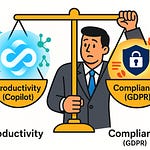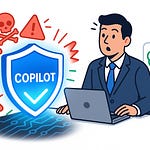Opening – Hook + Teaching Promise
You’re leaking data through Copilot Studio right now, and you don’t even know it.
Every time one of your bright, shiny new Copilot Agents runs, it inherits your permissions—every SharePoint library, every Outlook mailbox, every Dataverse table. It rummages through corporate data like an overeager intern who found the master key card. And unlike that intern, it doesn’t get tired or forget where the confidential folders are.
That’s the part too many teams miss: Copilot Studio gives you power automation wrapped in charm, but under the hood, it behaves precisely like you. If your profile can see finance data, your chatbot can see finance data. If you can punch through a restricted connector, so can every conversation your coworkers start with “Hey Copilot.” The result? A quiet but consistent leak of context—those accidental overshares hidden inside otherwise innocent answers.
By the end of this podcast, you’ll know exactly how to stop that. You’ll understand how to apply real Data Loss Prevention (DLP) policies to Copilot Studio so your agents stop slurping up whatever they please.
We’ll dissect why this happens, how Power Platform’s layered DLP enforcement actually works, and what Microsoft’s consent model means when your AI assistant suddenly decides it’s an archivist.
And yes, there’s one DLP rule that ninety percent of admins forget—the one that truly seals the gap. It isn’t hidden in a secret portal, it’s sitting in plain sight, quietly ignored. Let’s just say that after today, your agents will act less like unsupervised interns and more like disciplined employees who understand the word confidential.
Section 1: The Hidden Problem – Agents That Know Too Much
Here’s the uncomfortable truth: every Copilot Agent you publish behaves as an extension of the user who invokes it. Not a separate account. Not a managed identity unless you make it one. It borrows your token, impersonates your rights, and goes shopping in your data estate. It’s convenient—until someone asks about Q2 bonuses and the agent obligingly quotes from the finance plan.
Copilot Studio links connectors with evangelical enthusiasm. Outlook? Sure. SharePoint? Absolutely. Dataverse? Why not. Each connector seems harmless in isolation—just another doorway. Together, they form an entire complex of hallways with no security guard. The metaphor everyone loves is “digital intern”: energetic, fast, and utterly unsupervised. One minute it’s fetching customer details, the next it’s volunteering the full sales ledger to a chat window.
Here’s where competent organizations trip. They assume policy inheritance covers everything: if a user has DLP boundaries, surely their agents respect them. Unfortunately, that assumption dies at the boundary between the tenant and the Power Platform environment. Agents exist between those layers—too privileged for tenant restrictions, too autonomous for simple app policies. They occupy the gray space Microsoft engineers politely call “service context.” Translation: loophole.
Picture this disaster class scenario. A marketing coordinator connects the agent to Excel Online for campaign data, adds Dataverse for CRM insights, then saves without reviewing the connector classification. The DLP policy in that environment treats Excel as Business and Dataverse as Non‑Business. The moment someone chats, data crosses from one side to the other, and your compliance officer’s blood pressure spikes. Congratulations—your Copilot just built a makeshift export pipeline.
The paradox deepens because most admins configure DLP reactively. They notice trouble only after strange audit alerts appear or a curious manager asks, “Why is Copilot quoting private Teams posts?” By then the event logs show legitimate user tokens, meaning your so‑called leak looks exactly like proper usage. Nothing technically broke; it simply followed rules too loosely written.
This is why Microsoft keeps repeating that Copilot Studio doesn’t create new identities—it extends existing ones. So when you wonder who accessed that sensitive table, the answer may be depressing: you did, or at least your delegated shadow did. If your Copilot can see finance data, so can every curious chatbot session your employees open, because it doesn’t need to authenticate twice. It already sits inside your trusted session like a polite hitchhiker with full keychain access.
What most teams need to internalize is that “AI governance” isn’t just a fancy compliance bullet. It’s a survival layer. Permissions without containment lead to what auditors politely call “context inference.” That’s when a model doesn’t expose a file but paraphrases its contents from cache. Try explaining that to regulators.
Now, before you panic and start ripping out connectors, understand the goal isn’t to eliminate integration—it’s to shape it. DLP exists precisely to draw those bright lines: what counts as Business, what belongs in quarantine, what never touches network A if it speaks to network B. Done correctly, Copilot Studio becomes powerful and predictable. Done naively, it’s the world’s most enthusiastic leaker wrapped in a friendly chat interface.
So yes, the hidden problem isn’t malevolence; it’s inheritance. Your agents know too much because you granted them omniscience by design. The good news is that omniscience can be filtered. But to design the filter, you need to know how the data actually travels—through connectors, through logs, through analytic stores that never made it into your compliance diagram.
So, let’s dissect how data really moves inside your environment before we patch the leak—because until you understand the route, every DLP rule you write is just guesswork wrapped in false confidence.
Section 2: How Data Flows Through Copilot Studio
Let’s trace the route of one innocent‑looking question through Copilot Studio. A user types, “Show me our latest sales pipeline.” That request doesn’t travel in a straight line. It starts at the client interface—web, Teams, or embedded app—then passes through the Power Platform connector linked to a service like Dataverse. Dataverse checks the user’s token, retrieves the data, and delivers results back to the agent runtime. The runtime wraps those results into text and logs portions of the conversation for analytics. By the time the answer appears on‑screen, pieces of it have touched four different services and at least two separate audit systems.
That hopscotch path is the first vulnerability. Each junction—user token, connector, runtime, analytics—is a potential exfiltration point. When you grant a connector access, you’re not only allowing data retrieval. You’re creating a transit corridor where temporary cache, conversation snippets, and telemetry coexist. Those fragments may include sensitive values even when your output seems scrubbed. That’s why understanding the flow beats blindly trusting the UI’s cheerful checkboxes.
Now, connectors themselves come in varieties: Standard, Premium, and Custom. Standard connectors—SharePoint, Outlook, OneDrive—sit inside Microsoft’s managed envelope. Premium ones bridge into higher‑value systems like SQL Server or Salesforce. Custom connectors are the real wild cards; they can point anywhere an API and an access token exist. DLP treats each tier differently. A policy may forbid combining Custom with Business connectors, yet admins often test prototypes in mixed environments “just once.” Spoiler: “just once” quickly becomes “in production.”
Even connectors that feel safe—Excel Online, for instance—can betray you when paired with dynamic output. Suppose your agent queries an Excel sheet storing regional revenue, summarizes it, and pushes the result into a chat where context persists. The summarized numbers might later mingle with different data sources in analytics. The spreadsheet itself never left your tenant, but the meaning extracted from it did. That’s information leakage by inference, not by download.
Add another wrinkle: Microsoft’s defaults are scoped per environment, not across the tenant. Each Power Platform environment—Development, Test, Production—carries its own DLP configuration unless you deliberately replicate the policy. So when you say, “We already have a tenant‑wide DLP,” what you really have is a polite illusion. Unless you manually enforce the same classification each time a new environment spins up, your shiny Copilot in the sandbox might still pipe confidential records straight into a Non‑Business connector. Think of it as identical twins who share DNA but not discipline.
And environments multiply. Teams love spawning new ones for pilots, hackathons, or region‑specific bots. Every time they do, Microsoft helpfully clones permissions but not necessarily DLP boundaries. That’s why governance by memo—“Please remember to secure your environment”—fails. Data protection needs automation, not trust.
Let me illustrate with a story that’s become folklore in cautious IT circles. A global enterprise built a Copilot agent for customer support, proudly boasting an airtight app‑level policy. They assumed the DLP tied to that app extended to all sub‑components. When compliance later reviewed logs, they discovered the agent had been cross‑referencing CRM details stored in an unmanaged environment. The culprit? The DLP lived at the app layer; the agent executed at environment scope. The legal team used words not suitable for slides.
The truth is predictable yet ignored: DLP boundaries form at the connector‑environment intersection, not where marketing materials claim. Once a conversation begins, the system logs user input, connector responses, and telemetry into the conversation analytics store. That analytics layer—helpful for improving prompts—sits outside your original datacenter geography if you haven’t configured regional storage. So yes, compliance exposure can happen invisibly, inside the “helpful metrics” dashboard.
In essence, Copilot Studio’s data flow resembles a Rube Goldberg machine built by very polite engineers. Everything works, but in slightly more steps than intuition suggests. Each connector handshake and analytical echo adds another surface demanding policy oversight. Once you map those surfaces—user, connector, runtime, log—your DLP design stops being guesswork. Now you know precisely where to place controls.
So, with the arteries of data clearly visible, we’re ready to build the firewalls they deserve. The next step is turning that map into a fortress: deliberate classification, strict connector segregation, and environment consistency. Only then does your Copilot stop being a chatty courier and start behaving like a well‑trained employee who knows when to keep its mouth shut.
Section 3: Building the DLP Fortress – The Right Setup
Most admins mildly panic here—and good, fear keeps the data safe. The instinctive reaction is to open the Power Platform Admin Center and start toggling switches like a toddler near an elevator panel. Resist that. You’re not patching a bug; you’re constructing controlled walls around every connector your Copilot Studio agents can touch.
First, identify where those agents actually live. Copilot Studio projects don’t float freely; they sit inside specific Power Platform environments. Some are shared team spaces; others are sandbox or production tenants. Each of those environments may carry its own DLP policies—or none at all. In the Admin Center, list your environments and note which ones host active Copilot projects. That inventory alone separates you from the average admin still guessing in the dark.
Once you know the real estate, it’s blueprint time. DLP policies live under Data Policies → + New Policy. Give it a name you’ll remember under pressure—“AI_Containment_V1” has more gravitas than “test policy 3.” The core concept is classification: every connector in your tenant falls into one of three categories—Business, Non‑Business, or Blocked. Business connectors can talk to each other. Non‑Business connectors can talk among themselves. Cross‑chat between the two? Forbidden. Blocked connectors are excommunicated altogether.
Start populating that map. Place critical enterprise connectors—SharePoint, Outlook, OneDrive, Dataverse—inside Business. That’s your internal conversation circle. Then quarantine anything that reaches beyond corporate boundaries—Cognitive Services, Azure OpenAI, HTTP, and Custom APIs—into Non‑Business or Blocked. The temptation is always to keep them together “for flexibility.” Flexibility is how breaches breed. If creativity matters more than compliance, you’re in the wrong tutorial.
Here’s where most tenant security plans collapse: cross‑connection. Even a single workflow that moves data from one Business connector to a Non‑Business connector creates an implicit bridge. Imagine a Copilot pulling text from Outlook (Business) and sending it to OpenAI API for summarization (Non‑Business). That’s the textbook definition of exfiltration, just politely automated. The system doesn’t scream; it logs “Successful flow execution.” To DLP, that’s a violation neatly wrapped in normal operations.
Therefore, enforce strict segregation. In the policy editor, ensure Business and Non‑Business connectors never overlap in the same environment unless you have explicit legal sign‑off. Remember: DLP isn’t about blocking technology—it’s about preventing context transfer. Two environments with identical connectors but different classifications are infinitely safer than one environment with ambiguity.
Next, understand the hierarchy. Tenant‑level DLP policies override everything below them. Environment‑level policies override app‑specific ones. When conflicts arise, the most restrictive rule wins. That’s not fail‑safe by coincidence; it’s fail‑safe by hierarchy. If you define a connector as Blocked at the tenant level, no environment can resurrect it for testing. That rigidity saves careers.
The disciplined approach is to establish two tiers. Tier one: Tenant policy—the master barricade ensuring no wildcard connectors slip through. Tier two: Environment policies—fine‑tuned subsets matching department needs. Finance may classify SQL Server and SAP as Business, while Marketing lives happily without them. Resist the urge to copy and paste policies between environments. Replicate them through scripts or governance templates so updates propagate consistently. Consistency is dull; breaches are exciting. Choose dull.
Testing comes next, and yes, that means deliberate mischief. Spin up a sandbox environment devoted to chaos. Replicate your production configuration, but label it “Containment Test.” Attempt to connect a Business connector with a Non‑Business one. If the platform blocks you, your fortress holds. If it obliges without complaint, congratulations—you’ve found a hidden door. Adjust classifications and retest until rejection is the default outcome. That “Access Denied” message is the lullaby every compliance officer dreams of.
Before promoting policy to production, warn stakeholders. Users love blaming DLP for every failed automation like it’s a villain. Communicate why certain connectors lost their privileges. Transparency prevents rebellion. Then deploy the policy environment‑wide. Within hours, Copilot Studio agents attempting forbidden connections will fail silently, which is preferable to loudly compromising data.
And remember scope drift: new connectors arrive quietly through service updates. Without periodic reclassification, today’s safe list becomes tomorrow’s hole. Schedule quarterly reviews—or automate them with PowerShell scripts—to compare connector catalogs across environments. When Microsoft sneaks in a shiny new AI plug‑in, classify before curiosity strikes.
If all this feels heavy, good. You’re performing fortification, not decoration. DLP policies aren’t glamorous, but they convert enthusiastic automation into trustworthy infrastructure. Once your fortress stands—Business inside, Non‑Business outside, Blocked forever in the moat—you’ve finally earned the right to breathe.
But don’t celebrate yet. Every fortress needs guards who understand who’s allowed through the gate and on whose authority. That takes us to Entra—the identity police of your Microsoft ecosystem—and its dangerously misunderstood permission model. Spoiler alert: just because something says “Secure by Entra” doesn’t mean it’s actually yours.
Section 4: Permissions, Entra, and the Myth of Safety
“If it’s in Entra, it’s secure.”
Incorrect—spectacularly so. Entra ID provides identity; it doesn’t grant discipline. The difference matters. Your Copilot Agent doesn’t sign in as an independent entity; it piggybacks on the human behind the keyboard. The delegated token that validates you simultaneously becomes the passport for it. That’s delegated permission—not autonomous permission. In practice, it means your agent behaves like a very obedient thief: it only steals what you could’ve accessed anyway.
This is why gullible administrators sleep soundly while their agents rummage through sensitive libraries. They assume Entra’s authentication wall equals security, forgetting that an agent inside the wall is already past the moat. Copilot Studio relies on delegated permissions for connectors such as SharePoint or Outlook; those connectors don’t ask who’s really typing—they just honor the token. So the moment you, dear user, approve a connector, you’ve implicitly stamped “Unlimited Access” across every agent running under your context.
And yes, implicit consent is the silent saboteur here. Once one agent in an environment obtains authorization to a service, every other agent in that environment often inherits that trust automatically unless specifically restricted. It’s like giving a single intern the server keycard—and discovering on Monday that the entire intern class can now enter finance. Logic says consent should be granular. Reality says convenience sells.
The least‑privilege principle is your countermeasure. Restrict Copilot Studio environments with narrow, role‑based security groups. Instead of “everyone with Power Apps license,” define membership by function—Support, Finance, HR—each owning isolated environments. Agents should never share connector contexts across these boundaries.
Managed identities tempt many admins as a “simpler” fix. They do create separation but use them only where process automation truly replaces human action. Giving every Copilot its own managed identity feels neat until you realize you’ve spawned dozens of semi‑autonomous accounts wandering the tenant. Automation does not equal empowerment; it equals liability unless managed identities follow the same conditional‑access and MFA rules as living users.
Now, a brief reality check: Entra logs record every access attempt. Use them. In the Azure portal, pull Sign‑in Logs filtered by “Application ID contains PowerPlatform.” You’ll see who, or rather which agent, called which connector and under whose credentials. Pair that with Power Platform Admin Analytics to correlate connector traffic. If the same user appears authenticating hundreds of times from different channels, spoiler: the agent is working overtime on your token.
Segregate access remediation from audit analysis. The first defines policy; the second proves adherence. Once you identify cross‑environment token reuse, disable the shared connector and force fresh consent under explicit service principals. That one step alone cuts most rogue behavior by half.
In short, Entra doesn’t magically fix Copilot risk. It documents who invited the risk inside. Delegation means “my permissions are your permissions.” If you treat that as security, you deserve what follows.
We’ve now locked down identities and connectors. The fortress stands, the gate is guarded. But a fortress is useless if no one walks the walls. Governance without validation is just a beautiful diagram. So let’s test it.
Section 5: Testing and Monitoring – Prove It’s Sealed
Policies look invincible on paper. Reality is less romantic. You prove security the way scientists prove theories—with experiments. The first one: literal conversation testing. Ask your Copilot Agent for something it should never know. “Show me executive bonuses.” If it answers, you’ve failed. If it politely refuses with a generic message, that’s progress, though not proof.
Go further. Perform a red‑team simulation. Stage users with limited rights in non‑production environments. Have them probe the agent from various connectors. Monitor which requests are denied, which are cached, and which slip through. Document every near‑miss. This isn’t paranoia; it’s maintenance. A Copilot Agent responding to unauthorized queries doesn’t mean malevolence—it means your DLP policy has holes big enough to smuggle data through context.
While those tests run, open Power Platform Analytics. Under “Connector Usage by App,” filter for your Copilot projects. Look for spikes outside office hours or from service locations your staff never touch. Anomaly equals interest; interest equals investigation. Then forward these logs into Microsoft Purview for centralized auditing. Purview lets you merge Power Platform activity with SharePoint, Exchange, and Teams logs to see contextual chains like, “Agent retrieved file A → User sent summary to channel B.” Data lineage at its most honest.
Sentinel users can take it further—feed those events into a workspace and craft detection rules. Set an alert for any Copilot agent attempting cross‑environment queries or reaching out to HTTP endpoints not on your whitelist. When the alert fires, don’t blame the machine. Blame who approved the connector.
Now log retention. Purview’s Data Lifecycle Management allows you to set how long conversation and audit entries persist. Too short, and evidence vanishes before analysis. Too long, and you hoard metadata that becomes a compliance risk itself. Balance it like a budget: retain enough to prove due diligence, purge enough to avoid hoarding personal data you never meant to collect.
Each time Microsoft adds a new connector category, re‑classify it before someone experiments in production. DLP policies don’t automatically absorb new features; they inherit ignorance instead. Schedule monthly reviews to catch them. You can even script connector catalog exports and compare hashes between months. When a delta appears, that’s your cue to re‑lock the doors.
Monitoring should also include user education. Every time a DLP rule triggers, notify the initiating user why it failed. Silent blocks breed confusion and circumvention. A one‑line message—“This connector is restricted by policy AI_Containment_V1”—turns annoyance into awareness. Governance works best when the humans align with the machines.
Finally, treat monitoring as a living system. Feed findings back into policy updates. Flag connectors with recurring violations; consider moving them from Non‑Business to Blocked. When executives ask for metrics, show trend lines: decline in cross‑environment flows, reduced failed permission events, and mean time to policy update. That data tells a story even finance understands: compliance as productivity.
The critical lesson—nothing is secure because policy says so. It’s secure because logs, alerts, and humans say so every single day. When your Copilot answers only within the boundaries you’ve defined and every audit trail matches intention, you’ve moved from regulatory fiction to governance reality. Once your data stops leaking, you’ll see that this exercise was never about compliance checkboxes—it’s about control.
Conclusion – Key Takeaway + CTA
Here’s the bottom line: your Copilot Studio Agents are only as trustworthy as your DLP configuration. They don’t follow ethics; they follow tokens. Governance isn’t optional—it’s oxygen for any organization that lets AI anywhere near its data. If you treat Copilot as a toy, it’ll behave like one, juggling sensitive information until something drops in public view.
Lock your data before your Copilot learns too much. That single rule does more for compliance than a warehouse of audits. A properly built DLP fortress, reinforced by Entra permissions and monitored through Purview, converts risk into reliability. The real sophistication isn’t more automation—it’s controlled automation. You decide what knowledge exists where, and your agents comply because mathematics, not trust, enforces it.
Think of it this way: Copilot is the intern with infinite memory. Without supervision, it repeats every secret forever. With precise boundaries, it becomes the colleague who never violates confidentiality. If you’ve built your policies right, your next question can safely begin with “Hey Copilot” instead of “Oh no.”
So here’s your challenge—review your environment today. Open Power Platform Admin Center, examine every environment’s DLP mapping, cross‑check Purview audit connectors, and confirm Entra logs match the access patterns you intend. If any step surprises you, that’s where your next policy update belongs.
If this walkthrough saved your compliance team a panic attack, subscribe. It’s cheaper than an audit, easier than IRM training, and far less painful than explaining a data breach to executives. Updates from this channel arrive on time—structured, tested, reversible knowledge. Lock in your upgrade path: subscribe, enable alerts, and let governance deliver itself automatically. Proceed.










